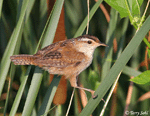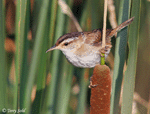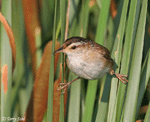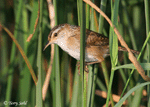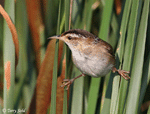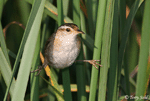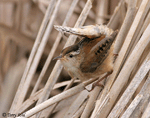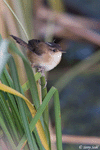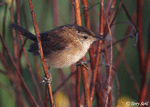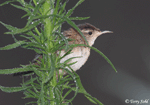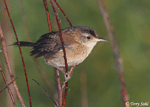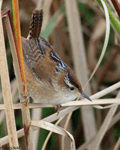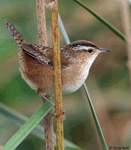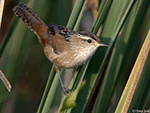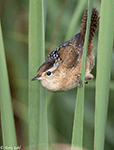Marsh Wren
Cistothorus palustris
| Length: 4.5 to 5 inches | Wingspan: 5.5 to 7 inches | Seasonality: Summer |
| ID Keys: (both sexes): Brown upperparts with black and white streaking in center of upper back, white underparts, bold white eyebrow, blackish-brown crown. | ||
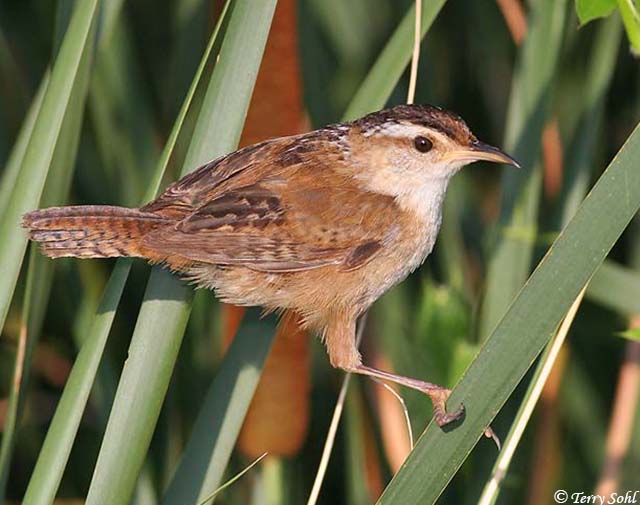 Cattail
marshes in South Dakota are usually occupied by Marsh Wrens. Sometimes
difficult to see in the dense wetland vegetation, their presence is still
unmistakable, with their bubbling songs a common sound in wetland habitats.
They are often very curious, responding to a human "pishing" and otherwise
checking out (and sometimes scolding) intruders in their domain. They have a
complex, chaotic courtship and nesting behavior, with birds mating with multiple
partners, and raids on nests of adjacent Marsh Wrens that often result in the
destruction of their eggs.
Cattail
marshes in South Dakota are usually occupied by Marsh Wrens. Sometimes
difficult to see in the dense wetland vegetation, their presence is still
unmistakable, with their bubbling songs a common sound in wetland habitats.
They are often very curious, responding to a human "pishing" and otherwise
checking out (and sometimes scolding) intruders in their domain. They have a
complex, chaotic courtship and nesting behavior, with birds mating with multiple
partners, and raids on nests of adjacent Marsh Wrens that often result in the
destruction of their eggs.
Habitat:
During the summer breeding season, they can be found in a variety of fresh- and brackish-water marshes, usually where dense stands of wetland vegetation (cattails, etc.) are present in shallow water or along the water's edges. Uses similar habitat during the winter, but will also use salt marshes.
Diet:
Primarily feeds on insects, both terrestrial and aquatic. Will also eat spiders and snails.
Behavior:
Forages in dense low vegetation, hunting for insects both on the vegetation and on the ground. They will often take items from the water's surface, and will also occasionally fly from a perch to take flying insects from mid-air.
Nesting:
June and July in South Dakota. The male begins courtship by building a number of incomplete nests, built in cattail marshes and other similar dense wetland vegetation. He allows a female to choose a final nesting site, where he finishes building a dome-shaped structure with the nest opening at the top. The female finishes the nest, lining it with feathers, down, fine grasses, and small roots. She lays between 3 and 10 eggs, and she alone incubates them. The eggs hatch after about 2 weeks, with the young fledging from the nest after about another 2 weeks.
Marsh Wrens are very competitive for nesting sites, with individual birds often destroying the eggs of nearby nesting birds. Individual birds may mate with other Marsh Wrens in the vicinity.
Song:
A gurgling, bubbly variable medley.
- 1Click here to hear the bubbling song of a Marsh Wren
- 2Click here to hear the short calls of a Marsh Wren
Migration:
Summers throughout much of the northern United States and Canada. Winters throughout the southwestern quarter of the United States, along the Pacific Coast, and in the deep southeastern U.S. Some populations along the Pacific Coast and in the western U.S. are permanent residents.
Interactive eBird Map:
Click here to access an interactive eBird map of Marsh Wren sightings
Similar Species:
They are often identified by habitat alone, given that other similar-looking wren species aren't found nearly as often around cattails and marshes. However, there are species that are similar in appearance and do sometimes overlap in range:
- Sedge Wren. - Sedge Wrens are found in wet meadows and grassy marshes, habitats that are often directly adjacent to the more dense wetland vegetation nearer water, such as areas of cattails. As such, both species can sometimes be found in the same general vicinity. Marsh Wrens however have a bold white eye stripe lacking on a Sedge Wren. Marsh Wrens have a solid brown shoulder, while a Sedge Wren has a heavily streaked shoulder.
- House Wren - House Wrens aren't normally found in the same habitats as Marsh Wrens, but there are times during migration when both species could conceivably be found in the same area. House Wrens lack the bold white eyebrow of a Marsh Wren, generally have less contrast and marking differences than a Marsh Wren, and lack the streaking found on the upper back of a Marsh Wren.
Conservation Status:
Numbers are probably much lower than historical levels due to the vast loss of wetlands throughout its normal range, but they currently appear to have stable populations to increasing populations. Still susceptible to local population loss when wetland habitats are lost. The IUCN currently considers the Marsh Wren to be a species of "Least Concern".
Further Information:
Photo Information:
July 26th, 2006 - Minnehaha County - Terry Sohl
Additional Photos:
Click on the image chips or text links below for additional, higher-resolution Marsh Wren photos.
Audio File Credits:
1Whitney Neufeld-Kaiser, from Washington State in March 2018. Original recording and information found on xeno-canto.
2Paul Marvin, from the Imperial Valley of Southern California on January 18th, 2018. Original recording and information found on xeno-canto.
| Click on the map below for a higher-resolution view |
 |
| South Dakota Status: Common summer breeding resident in the eastern part of the state. Less common in the west and local. |
Additional Marsh Wren Photos
Click for a higher-resolution version of these photos
